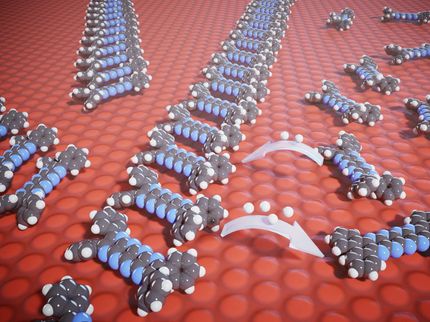Highly increased oxidation potentials due to adapted solvents
Scientists have succeeded in significantly increasing the oxidation potential of classic reagents.
Advertisement
NO+ dissolved in various fluorobenzenes. The more hydrogen atoms are replaced by fluorine atoms, the lower the interaction of the cations with the electrons and the less colored the solution. Photo and graphic: Dr. Malte Sellin

NO+ dissolved in various fluorobenzenes. The more hydrogen atoms are replaced by fluorine atoms, the lower the interaction of the cations with the electrons and the less colored the solution.
Dr. Malte Sellin
A team of scientists led by Prof. Dr. Ingo Krossing, Professor of Molecular and Coordination Chemistry at the Institute of Inorganic and Analytical Chemistry at the University of Freiburg, has succeeded in significantly increasing the oxidation potential of Ag+ and NO+ cations. While in conventional solvents and anions the potentials of these cations are up to +0.65 / +1.0 V vs. Fc+/0, the scientists presented potentials of up to +1.50 / +1.52 V vs. Fc+/0. This is achieved by using particularly weakly interacting solvents and anions. The working group focuses on strategically and polarity-maximizing substituted fluorinated benzene derivatives. With this new approach, redox reactions with systems that are difficult to oxidize or completely new applications in the field of electrocatalysis or redox shuttles/mediators are possible in the future. The scientists published their research results in the journal Nature Communications.
The weaker the interaction with the cation, the stronger the oxidation potential
Ag+ and NO+ cations are widely used oxidizing agents in chemistry and materials research. Under the right conditions, they can selectively remove electrons from substrates. As these cations are very small and have a high charge density, they interact strongly with their environment. It is precisely this strong interaction with the environment, for example the anion or the solvent, that leads to the oxidation potential of these cations also being greatly reduced. In order to maximize the oxidation power of the dissolved cations, the scientists used weakly coordinating anions (WCA) and solvents.
The working group used fluorinated benzene derivatives as solvents. In order to understand the properties of this class of molecules, Dr. Johannes Hunger from the Max Planck Institute for Polymer Research supported the research and determined the values of the dielectric constant, which is very important as a solvent property. Here it was shown that the doubly to quadruply fluorinated aromatics in particular have higher values in this aspect than conventional solvents such as dichloromethane or acetone.
While benzene itself or mono-fluorinated benzene still interacts strongly with the Ag+ and NO+ cations, the interaction decreases with each additional fluorine atom. "In addition to the electrochemical measurements, we used single-crystal X-ray diffraction to determine the solid-state structures of compounds from the solvents and the cations and were also able to show the lower interaction with increasing degree of fluorination," explains co-author Dr. Malte Sellin.
"These virtually undisturbed particles and their high oxidation potential enable us to achieve reactions that were previously unattainable," says Krossing. "This enables a variety of new fundamental chemical investigations and potentially also completely new applications. In future, we will have an even better understanding of how molecules behave in an oxidized state - simply because we can now also produce and study them."
Note: This article has been translated using a computer system without human intervention. LUMITOS offers these automatic translations to present a wider range of current news. Since this article has been translated with automatic translation, it is possible that it contains errors in vocabulary, syntax or grammar. The original article in German can be found here.
Original publication
Christian Armbruster, Malte Sellin, Matthis Seiler, Tanja Würz, Friederike Oesten, Maximilian Schmucker, Tabea Sterbak, Julia Fischer, Valentin Radtke, Johannes Hunger, Ingo Krossing; "Pushing redox potentials to highly positive values using inert fluorobenzenes and weakly coordinating anions"; Nature Communications, Volume 15, 2024-8-7

































































